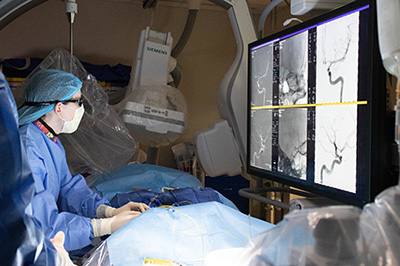
New Technology for Minimally Invasive Procedures
Published on Friday, September 10, 2021
By: Rachel Browning Truong, rbrowning2@umc.edu
Clipping, coiling, stents, pipelines, the vocabulary associated with a brain aneurysm goes on and on. Fortunately, new vocabulary means new technology and new technology means new treatment. Dr. Allison Strickland, a neurosurgeon at the University of Mississippi Medical Center, not only specializes in minimally invasive treatments for brain aneurysms but thrives at bringing the newest and most evolved techniques to her patients in Mississippi.
“The priority is always the patient and the ability to treat aneurysms or other malformations of the brain through a minimally invasive approach is just better for the patient,” said Dr. Strickland when asked about her interest in minimally invasive procedures.
A brain aneurysm is a weak area of an artery in the brain that causes a bulge or balloon in part of the vessel wall. As a result of injury, infection, inheritance or just wear and tear, aneurysms can affect anyone. A large un-ruptured aneurysm can cause pressure on surrounding brain tissue or nerves, creating pain, numbness, weakness, or paralysis. A ruptured aneurysm causes bleeding in the brain that could irritate, damage, or destroy brain cells creating symptoms like nausea, vomiting, stiff neck, or the worst headache of your life.
Decades ago, the only treatment for an aneurysm was surgical clipping that requires an open skull surgery called a craniotomy. While surgical clipping is still needed for some patients, less invasive techniques have been discovered. Most of these techniques are endovascular, meaning the problem area is reached through an artery requiring only a tiny incision.
Dr. Strickland has been the first neurosurgeon to use several minimally invasive devices here in Mississippi, the most recent being a type of stent called Pipeline Flex Embolization Device with Shield Technology. Deployed through a microcatheter, the original Pipeline Flex Embolization Device is a mesh, tube-like mechanism used to redirect blood flow. This tube is flexible enough to wind through bends in blood vessels and reconstruct the vessel walls where an aneurysm has formed. With the stent in place, blood flow is redirected through the surrounding healthy artery, passing over the problem area. With time, the vessel wall forms new tissue over the stent.
The original Pipeline Flex Embolization Device addresses the problems caused by an aneurysm. Patients are required to take blood thinning medications before and after this procedure to prevent blood clots from forming on the stent. The new device with Shield Technology does not require dual anti-platelets because it has a coating on the stent that prevents the formation of blood clots.

“The Pipeline Flex Embolization Device with Shield Technology delivered more smoothly than the prior generation device. This is a great advancement for the future of endovascular surgery. With this technology, future patients will no longer have to take dual anti-platelet medications before and after placement of an intracranial flow diverter,” said Dr. Strickland.
Antiplatelet, or blood thinning medications, come with their own risks and potential side effects, but are necessary in most cases of intracranial stenting. The Shield Technology takes this already minimally invasive procedure to the next level by removing the need for these potentially harmful medications.
With access to new and innovative technology, physicians like Dr. Strickland help keep UMMC at the forefront of medicine, offering the highest quality of care. As Dr. Strickland said, patients are the top priority.


